Modest Irrigation Frequency Improves Maize Water Use Efficiency and Influences Trait Expression
Abstract
1. Introduction
2. Materials and Methods
2.1. Study Site
2.2. Experimental Design
- -
- 100 mm: 100 mm applied once a week over the irrigation season;
- -
- 55 mm: 55 mm applied once a week over the irrigation season;
- -
- AMP: ANPROMIS-recommended weekly irrigation volume, applied once a week;
- -
- 100/2 mm: 50 mm applied biweekly over the irrigation season;
- -
- 55/2 mm: 27.5 mm applied biweekly over the irrigation season;
- -
- AMP/2: ANPROMIS-recommended weekly irrigation volume, split into two applications per week.
2.3. Plant Growth and Ear Traits Analysis
2.4. Assessment of Soil Properties
2.5. Statistical Analysis
3. Results and Discussion
3.1. Soil Properties
3.2. Plant Development
3.3. Phenotypic Traits
3.3.1. Number of Ears
3.3.2. Ear Length and Weight
3.3.3. Kernel Weight and Number
3.4. Grain Yield and Water Use Efficiency
3.4.1. Grain Yield
3.4.2. Water Use Efficiency
3.5. Limitations and Future Research Directions
4. Conclusions
Author Contributions
Funding
Institutional Review Board Statement
Informed Consent Statement
Data Availability Statement
Acknowledgments
Conflicts of Interest
References
- FAOSTAT Agricultural Production Statistics 2000–2022. 2022. Available online: https://www.fao.org/statistics/highlights-archive/highlights-detail/agricultural-production-statistics-(2000-2022)/en (accessed on 15 November 2024).
- Hammad, H.M.; Chawla, M.S.; Jawad, R.; Alhuqail, A.; Bakhat, H.F.; Farhad, W.; Khan, F.; Mubeen, M.; Shah, A.N.; Liu, K.; et al. Evaluating the Impact of Nitrogen Application on Growth and Productivity of Maize Under Control Conditions. Front. Plant Sci. 2022, 13, 885479. [Google Scholar] [CrossRef]
- ANPROMIS. Área de Culturas Arvenses em Portugal Continental (2018 a 2024). Available online: https://anpromis.pt/dados-estatisticos/19-area-de-culturas-arvenses-em-portugal.html (accessed on 17 July 2025). (In Portuguese).
- Boone, L.; De Meester, S.; Vandecasteele, B.; Muylle, H.; Roldán-Ruiz, I.; Nemecek, T.; Dewulf, J. Environmental life cycle assessment of grain maize production: An analysis of factors causing variability. Sci. Total Environ. 2016, 553, 551–564. [Google Scholar] [CrossRef]
- Kumar, D.; Jhariya, A.N. Nutritional, medicinal and economical importance of corn: A mini review. Res. J. Pharm. Sci. 2013, 2, 7–8. [Google Scholar]
- Aghaei, S.; Alavijeh, M.K.; Shafiei, M.; Karimi, K.A. comprehensive review on bioethanol production from corn stover: Worldwide potential, environmental importance, and perspectives. Biomass Bioenergy 2022, 161, 106447. [Google Scholar] [CrossRef]
- Lobell, D.B.; Schlenker, W.; Costa-Roberts, J. Climate trends and global crop production since 1980. Science 2011, 333, 616–620. [Google Scholar] [CrossRef] [PubMed]
- Hatfield, J.L.; Prueger, J.H. Temperature extremes: Effect on plant growth and development. Weather Clim. Extrem. 2015, 10, 4–10. [Google Scholar] [CrossRef]
- Zhao, J.; Marek, T.H.; Liu, K.; Harrison, M.T.; Xue, Q. Drought tolerant maize hybrids have higher yields and lower water use under drought conditions at a regional scale. Agric. Water Manag. 2022, 274, 107978. [Google Scholar] [CrossRef]
- de Oliveira, L.A.; de Miranda, J.H.; Cooke, R.A. Water management for sugarcane and corn under future climate scenarios in Brazil. Agric. Water Manag. 2018, 201, 199–206. [Google Scholar] [CrossRef]
- Piati, G.; Ferreira de Lima, S.; Lustosa Sobrinho, R.; dos Santos, O.F.; Vendruscolo, E.P.; Jacinto de Oliveira, J.; do Nascimento de Araújo, T.A.; Mubarak Alwutayd, K.; Finatto, T.; AbdElgawad, H. Biostimulants in Corn Cultivation as a Means to Alleviate the Impacts of Irregular Water Regimes Induced by Climate Change. Plants 2023, 12, 2569. [Google Scholar] [CrossRef]
- Vargas-Amelin, E.; Pindado, P. The challenge of climate change in Spain: Water resources, agriculture and land. J. Hydrol. 2014, 518, 243–249. [Google Scholar] [CrossRef]
- Piscitelli, L.; Colovic, M.; Aly, A.; Hamze, M.; Todorovic, M.; Cantore, V.; Albrizio, R. Adaptive agricultural strategies for facing water deficit in sweet maize production: A case study of a semi-arid mediterranean region. Water 2021, 13, 3285. [Google Scholar] [CrossRef]
- Fekonja, M.; Bavec, F.; Grobelnik-Mlakar, S.; Turinek, M.; Jakop, M.; Bavec, M. Growth performance of sweet maize under non-typical maize growing conditions. Biol. Agric. Hortic. 2011, 27, 147–164. [Google Scholar] [CrossRef]
- Rolim, J.; Paço, T.; Rolim, J. Climate Change Impacts on Irrigation Water Requirements under Mediterranean Conditions—A Review of the Methodological Approaches Focusing on Maize Crop. Agronomy 2023, 13, 117. [Google Scholar]
- Baum, M.E.; Licht, M.A.; Huber, I.; Archontoulis, S.V. Impacts of climate change on the optimum planting date of different maize cultivars in the central US Corn Belt. Eur. J. Agron. 2020, 119, 126101. [Google Scholar] [CrossRef]
- Couto, A.; Padín, A.R.; Reinoso, B. Comparative yield and water use efficiency of two maize hybrids differing in maturity under solid set sprinkler and two different lateral spacing drip irrigation systems in León, Spain. Agric. Water Manag. 2013, 124, 77–84. [Google Scholar] [CrossRef]
- Bwambale, E.; Abagale, F.K.; Anornu, G.K. Smart irrigation monitoring and control strategies for improving water use efficiency in precision agriculture: A review. Agric. Water Manag. 2022, 206, 107624. [Google Scholar] [CrossRef]
- Ferreira, C.S.S.; Soares, P.R.; Guilherme, R.; Vitali, G.; Boulet, A.; Harrison, M.T.; Malamiri, H.; Duarte, A.; Kalantari, Z.; Ferreira, A.J.D. Sustainable Water Management in Horticulture: Problems, Premises, and Promises. Horticulture 2024, 10, 951. [Google Scholar] [CrossRef]
- Hassanli, A.M.; Ebrahimizadeh, M.A.; Beecham, S. The effects of irrigation methods with effluent and irrigation scheduling on water use efficiency and corn yields in an arid region. Agric. Water Manag. 2009, 96, 93–99. [Google Scholar] [CrossRef]
- Széles, A.; Huzsvai, L.; Mohammed, S.; Nyéki, A.; Zagyi, P.; Horváth, E.; Simon, K.; Arshad, S.; Tamás, A. Precision agricultural technology for advanced monitoring of maize yield under different fertilization and irrigation regimes: A case study in Eastern Hungary (Debrecen). J. Agric. Food Res. 2024, 15, 100967. [Google Scholar] [CrossRef]
- Sharafkhane, M.; Ziaei, A.; Naghedifar, S.; Akbari, A.; Verdi, A. AquaCrop Plug-in-PSO: A novel irrigation scheduling optimization framework for maize to maximize crop water productivity using in-season weather forecast and crop yield estimation. Agric. Water Manag. 2024, 306, 109453. [Google Scholar] [CrossRef]
- Jahangirlou, M.; Akbari, G.; Alhdadi, I.; Soufizadeh, S.; Kumar, U.; Parsons, D. Phenotypic Traits, Grain Yield and Yield Components of Maize Cultivars Under Combinations of Management Practices in Semi-arid Conditions of Iran. Int. J. Plant Prod. 2021, 15, 459–471. [Google Scholar] [CrossRef]
- Tao, R.; Zhao, P.; Wu, J.; Martin, N.F.; Harrison, M.T.; Ferreira, C.; Kalantari, Z.; Hovakimyan, N. Optimizing Crop Management with Reinforcement Learning and Imitation Learning. arXiv 2022, arXiv:2209.09991. [Google Scholar]
- Amissah, S.; Ankomah, G.; Agyei, B.K.; Lee, R.D.; Harris, G.H.; Cabrera, M.; Franklin, D.H.; Diaz-Perez, J.C.; Habteselassie, M.Y.; Sintim, H.Y. Nutrient Sufficiency Ranges for Corn at the Early Growth Stage: Implications for Nutrient Management. Plants 2023, 12, 713. [Google Scholar] [CrossRef]
- Ahmad, I.; Ahmad, B.; Boote, K.; Hoogenboom, G. Adaptation strategies for maize production under climate change for semi-arid environments. Eur. J. Agron. 2020, 115, 126040. [Google Scholar] [CrossRef]
- Porcuna-Ferrer, A.; Calvet-Mir, L.; Faye, N.F.; Klappoth, B.; Reyes-García, V.; Labeyrie, V. Drought-tolerant indigenous crop decline in the face of climate change: A political agroecology account from south-eastern Senegal. J. Rural Stud. 2024, 105, 103163. [Google Scholar] [CrossRef]
- Costa, J.M.; Tejero, I.F.G.; Zuazo, V.H.D.; da Lima, R.S.N.; Chaves, M.M.; Patto, M.C.V. Thermal imaging to phenotype traditional maize landraces for drought tolerance. Comun. Sci. 2015, 6, 334–343. [Google Scholar] [CrossRef]
- Ceccarelli, S.; Grando, S. Decentralized Participatory Plant Breeding: Adapting Crops to Environments and Clients. Ecol. Soc. 2007, 12, 26. [Google Scholar]
- Boulet, A.K.; Alarcão, C.; Ferreira, C.; Kalantari, Z.; Veiga, A.; Campos, L.; Ferreira, A.; Hessel, R. Agro-ecological services delivered by legume cover crops grown in succession with grain corn crops in the Mediterranean region. Open Agric. 2021, 6, 609–626. [Google Scholar] [CrossRef]
- Moreira, P.M.M.; Pêgo, S.E.; Vaz Patto, C.; Hallauer, A.R. Comparison of selection methods on ‘Pigarro’, a Portuguese improved maize population with fasciation expression. Euphytica 2008, 163, 481–499. [Google Scholar] [CrossRef]
- Revilla, P.; Alves, M.L.; Andelković, V.; Balconi, C.; Dinis, I.; Mendes-Moreira, P.; Redaelli, R.; Ruiz de Galarreta, J.I.; Vaz Patto, M.C.; Žilić, S. Traditional foods from maize (Zea mays L.) in Europe. Front. Nutr. 2022, 8, 683399. [Google Scholar] [CrossRef]
- Ferreira, C.S.S.; Walsh, R.P.D.; Nunes, J.P.C.; Steenhuis, T.S.; Nunes, M.; de Lima, J.L.M.P.; Coelho, C.O.A.; Ferreira, A.J.D. Impact of urban development on streamflow regime of a Portuguese peri-urban Mediterranean catchment. J. Soils Sediments 2016, 16, 2580–2593. [Google Scholar] [CrossRef]
- Santos, M.; Boletins com as Recomendações de Rega Para o Milho. Webinar “Alterações Climáticas e a Cultura do Milho”, ANPROMIS. 2025. Available online: https://www.anpromis.pt/images/Webinar_Alteracoes_Climaticas_2025/Boletins-com-as-Recomendaes-de-Rega-para-o-Milho_Marta-Santos_COTR_compressed_compressed.pdf (accessed on 17 July 2025). (In Portuguese).
- Bettencourt, E.; Carolino, S. Descriptores Para O Milho; Bioversity International: Rome, Italy, 2000. [Google Scholar]
- Moreira, P.M.; Santos, J.P.; Simões, P.; Santos, J.P.; Vaz Patto, M.C.; Carvalho, V.; Pego, S. Pré-avaliação de Populações de Milhos Regionais da Região Centro. Parâmetros Biométricos e Fitossanitários. In Proceedings of the VII Encontro Nacional de Protecção Integrada, Coimbra, Portugal, 6–7 December 2005; Cunha, M.J., Ed.; pp. 284–296. [Google Scholar]
- Chen, X.; Zhang, K.; Gao, X.; Ai, X.; Chen, G.; Guo, X.; Wu, C.; Zhang, L. Effect of irrigation with magnetized and ionized water on yield, nutrient uptake and water-use efficiency of winter wheat in Xinjiang, China. Agric. Water Manag. 2025, 308, 109292. [Google Scholar] [CrossRef]
- ISO 10390:2021; Soil, Treated Biowaste and Sludge–Determination of Ph. International Organization for Standardization: Geneva, Switzerland, 2021.
- ISO 10694:1995; Determination of Organic and Total Carbon After Dry Combustion (Elementary Analysis). International Organization for Standardization: Geneva, Switzerland, 1995.
- Bremner, J. Total nitrogen. Methods Soil Anal. Part 2 Chem. Microbiol. Prop. 1965, 9, 1149–1178. [Google Scholar]
- ISO 3696:1987; Water for Analytical Laboratory Use-Specification and Test Methods. International Organization for Standardization: Geneva, Switzerland, 1987.
- Panagos, P.; Rosa, D.; Liakos, L.; Labouyrie, M.; Borrelli, P.; Ballabio, C. Soil bulk density assessment in Europe. Agric. Ecosyst. Environ. 2024, 364, 108907. [Google Scholar] [CrossRef]
- Wang, X.; Zhou, B.; Sun, X.; Yue, Y.; Ma, W.; Zhao, M. Soil Tillage Management Affects Maize Grain Yield by Regulating Spatial Distribution Coordination of Roots, Soil Moisture and Nitrogen Status. PLoS ONE 2015, 10, e0129231. [Google Scholar] [CrossRef]
- Veloso, A.; Sempiterno, C.; Calouro, F.; Rebelo, F.; Pedra, F.; Castro, I.; Gonçalves, M.; Marcelo, M.; Pereira, P.; Fareleira, P.; et al. Manual De Fertilização das Culturas; INIAV–Instituto Nacional de Investigação Agrária e Veterinária, I.P: Oeiras, Portugal, 2022; ISBN 978-972-579-063-2. [Google Scholar]
- Carvalho, M.; Lourenço, E. Conservation Agriculture–A Portuguese Case Study. J. Agron. Crop Sci. 2014, 200, 317–324. [Google Scholar] [CrossRef]
- Acevedo, M.; Pixley, K.; Zinyengere, N.; Meng, S.; Tufan, H.; Cichy, K.; Bizikova, L.; Isaacs, K.; Kopel, K.; Porciello, J. A scoping review of adoption of climate-resilient crops by small-scale producers in low- and middle-income countries. Nat. Plants 2020, 6, 1231–1241. [Google Scholar] [CrossRef]
- Mattila, T.; Hakkinen, L. Exploring the effects of soil structure, nutrients, and farm management on crop root biomass and depth distribution. Field Crops Res. 2025, 327, 109909. [Google Scholar] [CrossRef]
- Payero, J.O.; Tarkalson, D.D.; Irmak, S.; Davison, D.; Petersen, J.L. Effect of timing of a deficit-irrigation allocation on corn evapotranspiration, yield, water use efficiency and dry mass. Agric. Water Manag. 2009, 96, 1387–1397. [Google Scholar] [CrossRef]
- Otegui, M.E.; Andrade, F.H.; Suero, E.E. Growth, water use, and kernel abortion of maize subjected to drought at silking. Field Crops Res. 1995, 40, 87–94. [Google Scholar] [CrossRef]
- Ionunescu, N.; Georgescu, M.; Badea, O.; Podea, M. Variations of current maize (Zea mays L.) cobs by morphological characters. Sci. Pap. 2020, LXIII, 1. [Google Scholar]
- Juan, M.; Yan-yong, C.; Zhu, W. Genome-Wide Prediction Analysis for Ear Cob Diameter and Kernel Ratio in Maize. J. Plant Genet. Resour. 2021, 22, 1708–1715. [Google Scholar]
- Vaz Patto, M.; Moreira, P.; Carvalho, V.; Pego, S. Collecting maize (Zea mays L. convar. mays) with potential technological ability for bread making in Portugal. Genet. Resour. Crop Evol. 2007, 54, 1555–1563. [Google Scholar] [CrossRef]
- Wang, X.; Zenda, T.; Liu, S.; Liu, G.; Jin, H.; Dai, L.; Dong, A. Comparative proteomics and physiological analyses reveal important maize filling-kernel drought-responsive genes and metabolic pathways. Int. J. Mol. Sci. 2019, 20, 3743. [Google Scholar] [CrossRef]
- Zhou, G.; Zhu, Q.; Yang, G.; Huang, J.; Cheng, S.; Yue, B.; Zhang, Z. qEL7.2 is a pleiotropic QTL for kernel number per row, ear length and ear weight in maize (Zea mays L.). Euphytica 2015, 203, 429–436. [Google Scholar] [CrossRef]
- Cakir, R. Effect of water stress at different development stages on vegetative and reproductive growth of corn. Field Crops Res. 2004, 89, 1–16. [Google Scholar] [CrossRef]
- Liu, Z.; Hu, C.; Wang, Y.; Sha, Y.; Hao, Z.; Chen, F.; Yuan, L.; Mi, G. Nitrogen allocation and remobilization contributing to low-nitrogen tolerance in stay-green maize. Field Crops Res. 2021, 263, 108078. [Google Scholar] [CrossRef]
- Gao, J.; Liu, N.; Wang, L.; Niu, Z.; Liao, Q.; Ding, R.; Du, T.; Kang, S.; Tong, L. Maintaining grain number by reducing grain abortion is the key to improve water use efficiency of maize under deficit irrigation and salt stress. Agric. Water Manag. 2024, 294, 108727. [Google Scholar] [CrossRef]
- Roth, G.W.; Fox, R.H. Soil nitrate accumulation and loss under conventional and no-tillage corn production. Agron. J. 1990, 82, 287–291. [Google Scholar]
- Ko, J.; Piccinni, G. Corn yield responses under crop evapotranspiration-based irrigation management. Agric. Water Manag. 2009, 96, 799–808. [Google Scholar] [CrossRef]
- Camargo-Alvarez, H.; Elliott, R.; Olin, S.; Wang, X.; Wang, C.; Ray, D.; Pugh, T. Modelling crop yield and harvest index: The role of carbon assimilation and allocation parameters. Model. Earth Syst. Environ. 2022, 9, 2617–2635. [Google Scholar] [CrossRef]
- Wang, L.; Liu, X.; Liu, X.; Bao, X.; Zhang, X.; Yin, B.; Wang, W.; Wang, Y.; Zhen, W. Effects of spring limited irrigation on grain yield and root characteristics of winter wheat in groundwater-overexploitation areas in the North China Plain. Agric. Water Manag. 2024, 294, 108729. [Google Scholar] [CrossRef]
- Mendes-Moreira, P.; Alves, M.L.; Satovic, Z.; Dos Santos, J.P.; Santos, J.N.; Souza, J.C.; Pego, S.E.; Hallauer, A.R.; Vaz Patto, M.C. Genetic architecture of ear fasciation in maize (Zea mays) under QTL scrutiny. PLoS ONE 2015, 10, e0124543. [Google Scholar] [CrossRef]
- Zou, Y.; Saddique, Q.; Ali, A.; Xu, J.; Khan, M.I.; Qing, M.; Azmat, M.; Cai, H.; Siddique, K.H. Deficit irrigation improves maize yield and water use efficiency in a semi-arid environment. Agric. Water Manag. 2021, 243, 106483. [Google Scholar] [CrossRef]
- Irmak, S.; Odhiambo, L.O.; Kranz, W.L.; Eisenhauer, D.E. Irrigation Efficiency and Uniformity, and Crop Water Use Efficiency. Biol. Syst. Eng. Pap. Publ. 2011, 451. Available online: https://digitalcommons.unl.edu/cgi/viewcontent.cgi?article=1455&context=biosysengfacpub (accessed on 17 July 2025).
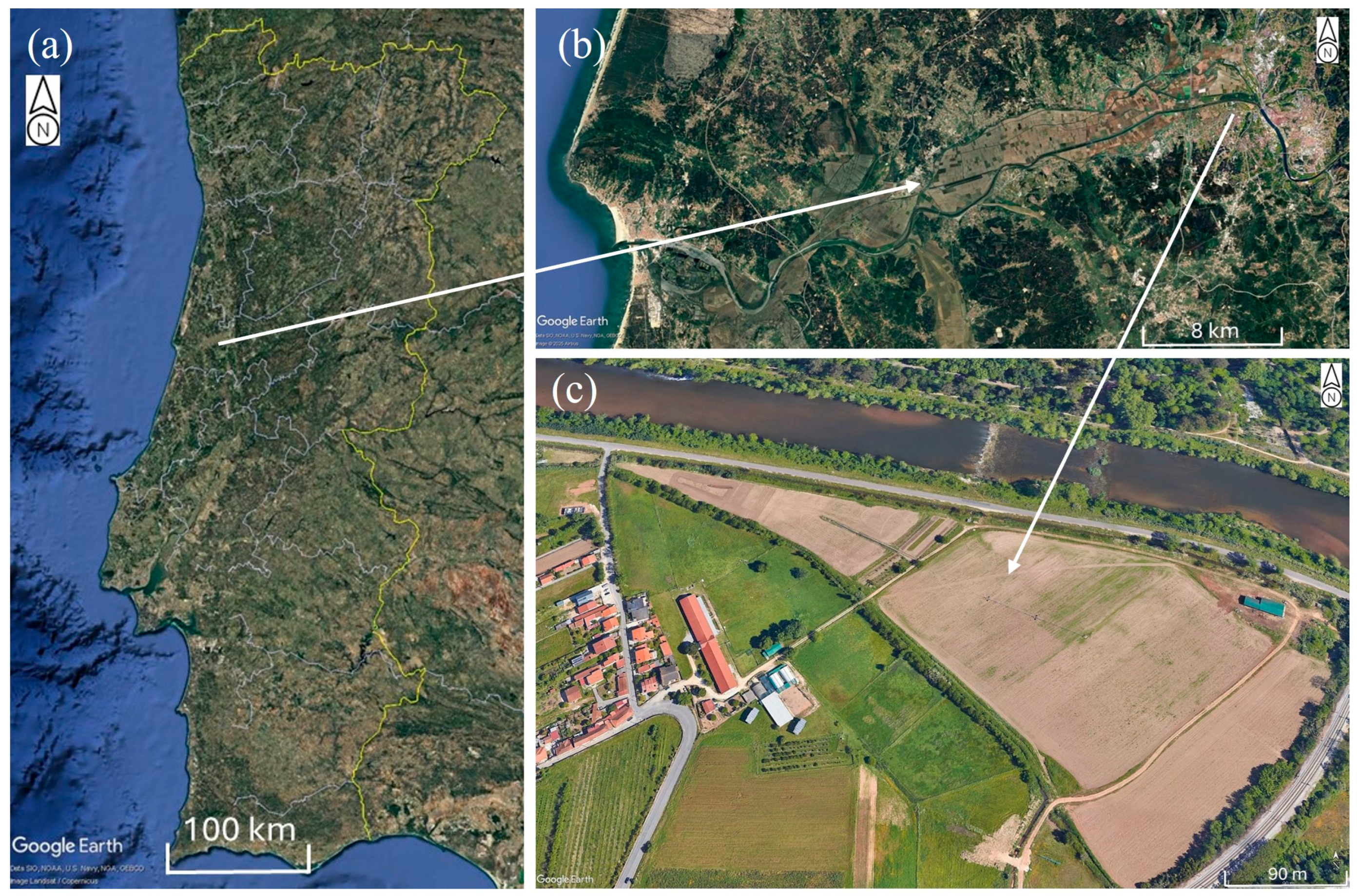
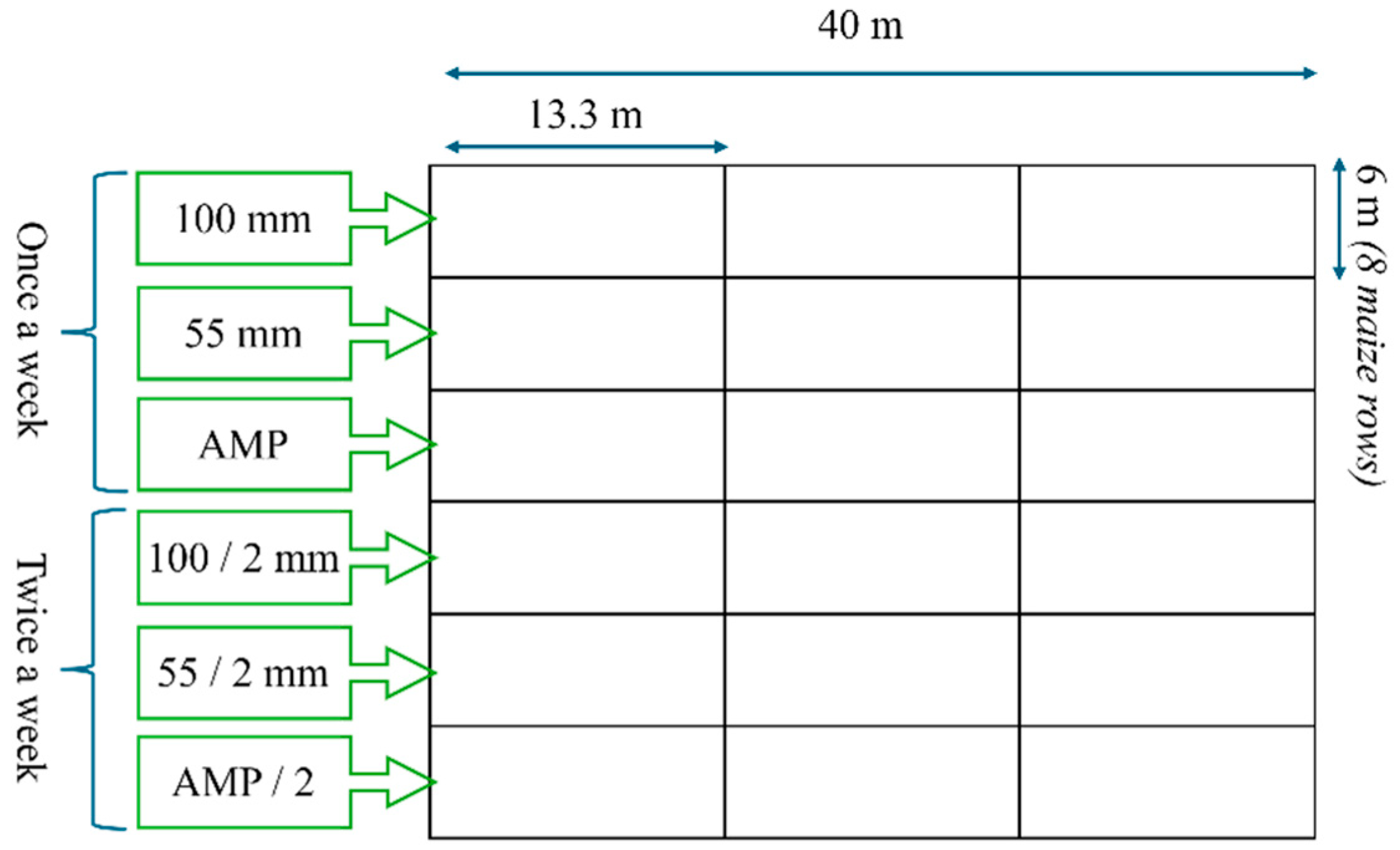
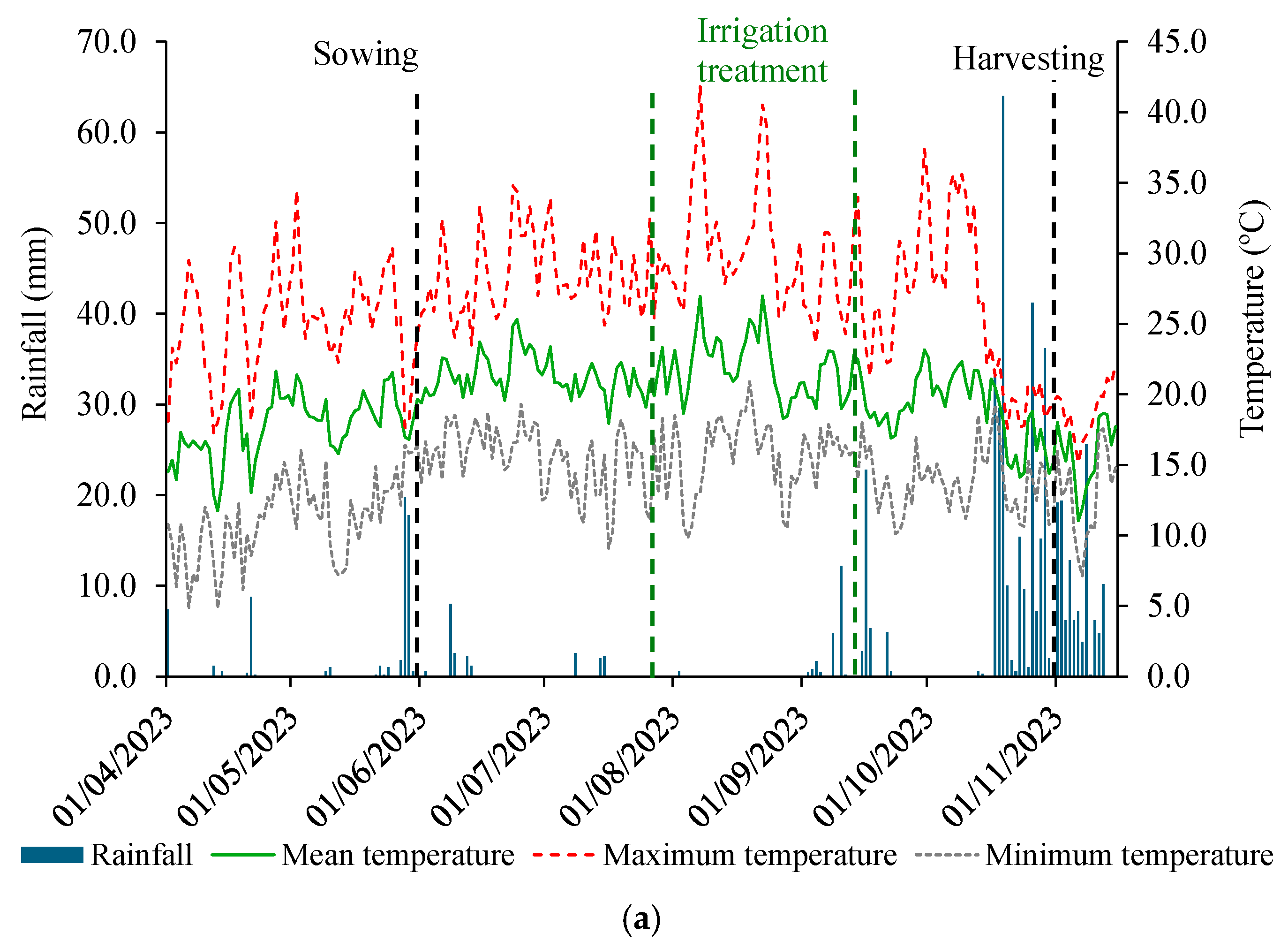

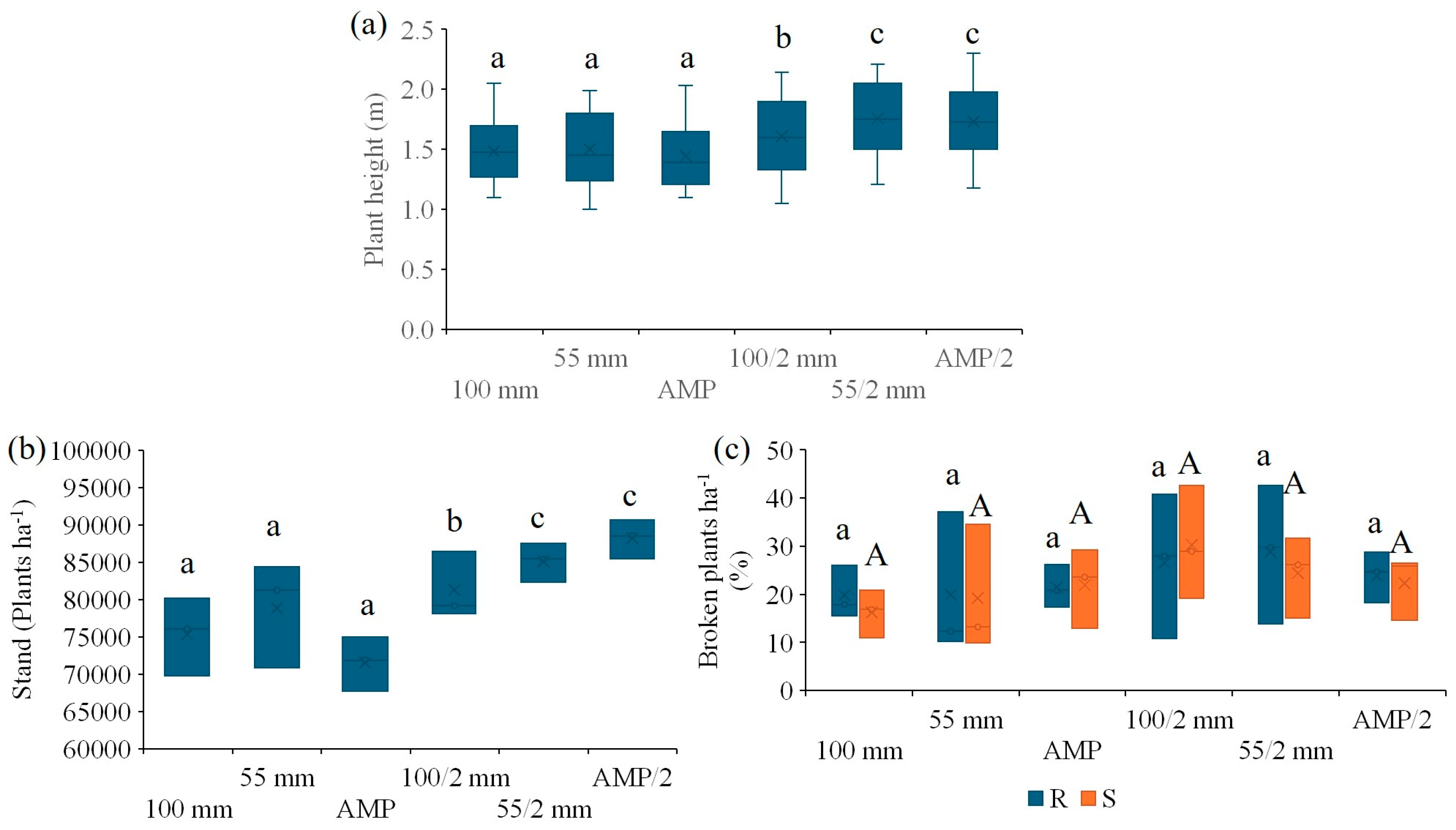
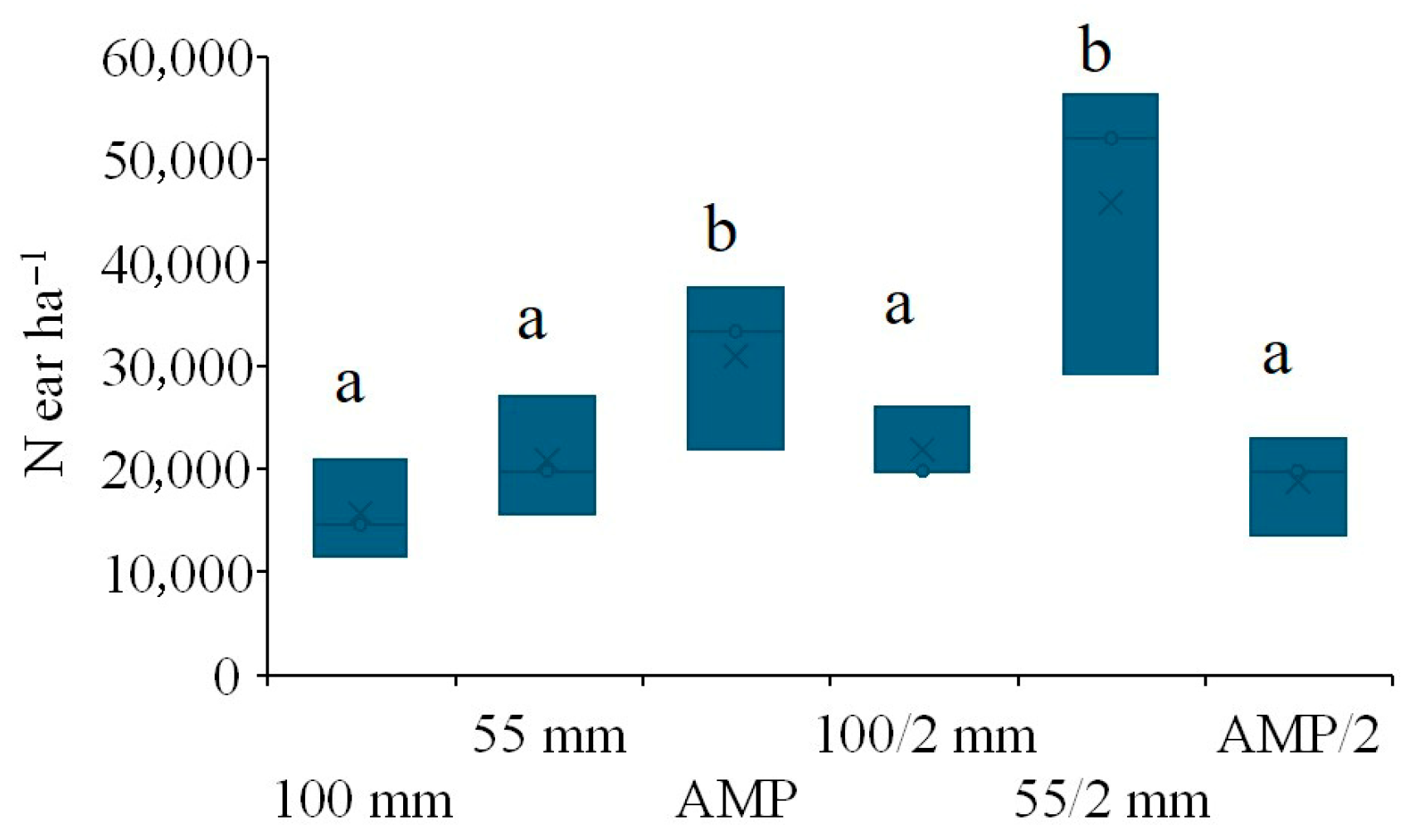
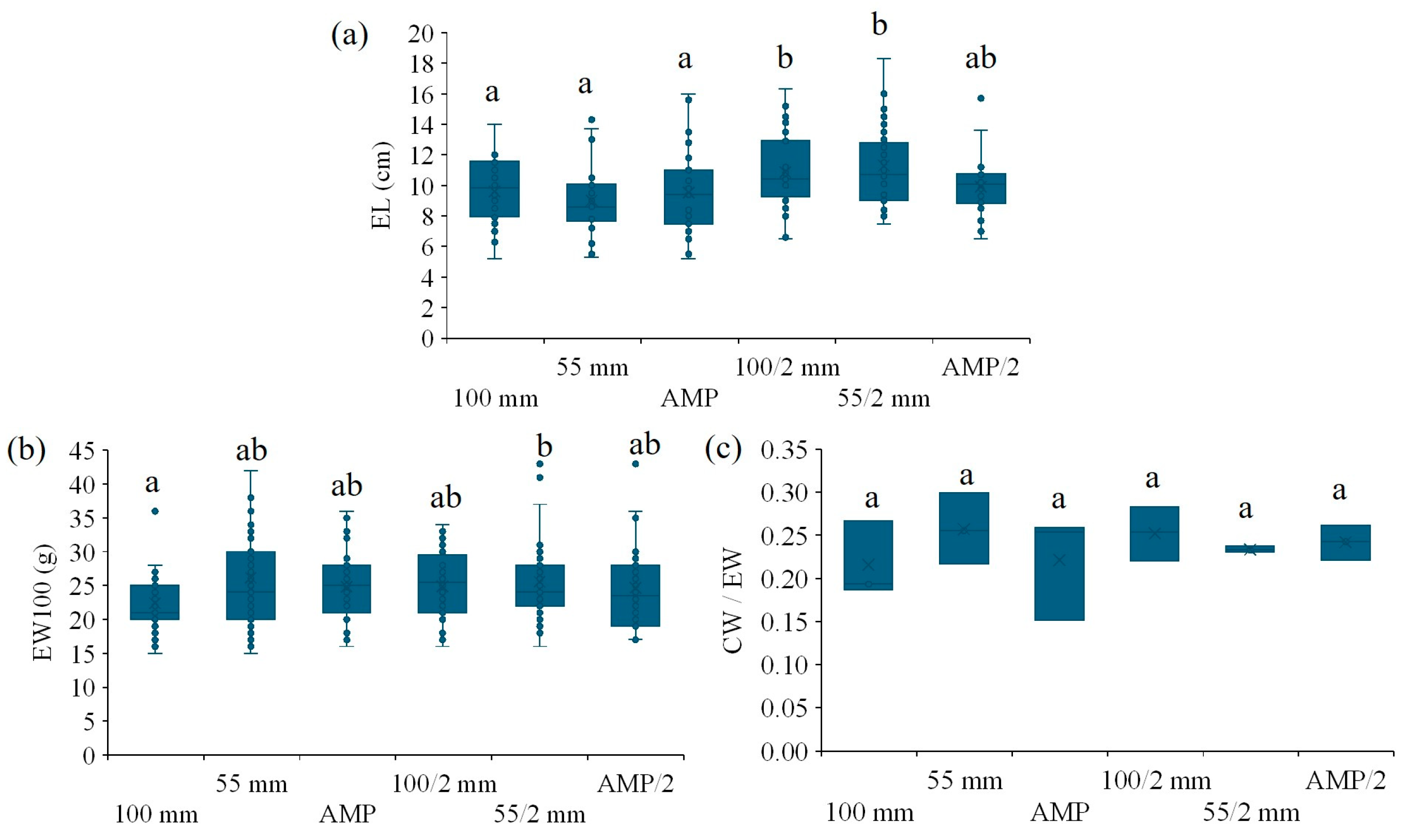

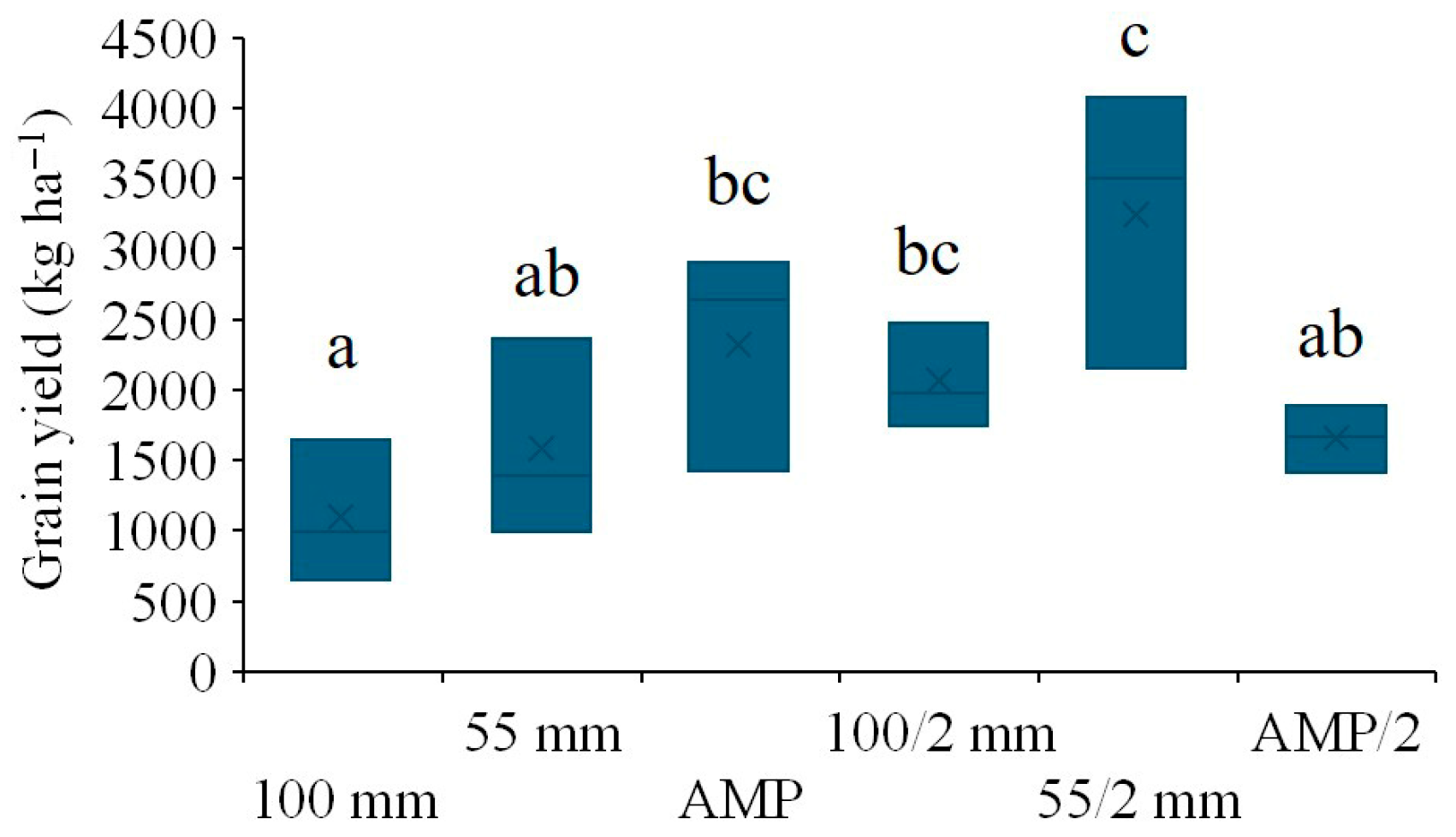
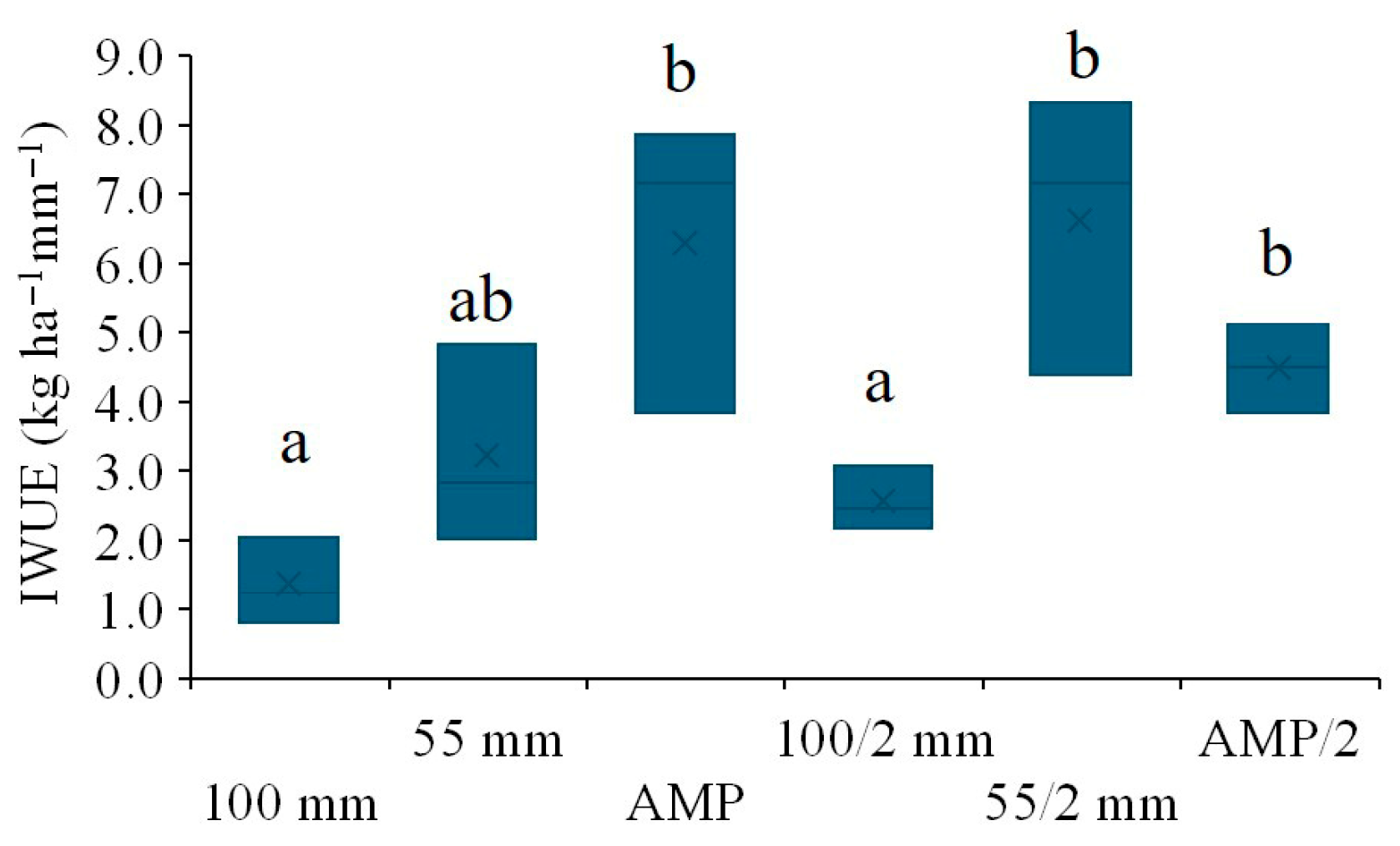
| Traits | Type of Data | Description | |
|---|---|---|---|
| Plant | Height (H) | 21 plants per plot | Height of the plant, from the base of the stem to the last insertion of leaves before the tassel (cm); |
| Stand | - | Total number of plants per plot; | |
| Broken by root (R) | - | Number of plants broken by the root; | |
| Broken by stem (S) | - | Number of plants broken by the stem; | |
| Ear | Number (Near) | Number of ears of maize; | |
| Weight (EW) | Weight of an ear (g); | ||
| 100 weight (EW100) | 11 ears | Weight of 100 ears for a value of 15% moisture (g); | |
| Length (EL) | 11 ears | Distance between the ends of the ear (cm); | |
| Cob | Weight (CW) | 11 ears | Cob maize weight per ear, adjusted to 15% moisture (g); |
| Cob weight/Ear weight (CW/EW) | 11 ears | Ratio between the cob weight and the ear weight; | |
| Kernel | Kernel weight (KW) | 11 ears | Kernel weight per ear, obtained indirectly by the difference between EW and CW; |
| Kernel depth (KD) | 11 ears | Kernel depth from the insertion site of the rachis to the opposite end (cm); | |
| Number per row (NC) | 11 ears | Kernel number in an average row of the ear; | |
| Grain yield (GY) | 11 plants | Grain yield of 11 plants harvested manually, with weight adjusted to 15% moisture; the soil moisture correction was calculated as follows: Grain yield 15% moisture = Grain yield/ha × (100% − %moisture at harvest)/(100% − 15% moisture) (kg/ha). |
| Bulk Density (g cm−3) | pH | Electrical Conductivity (µS/cm) | OM (%) | N (%) | P2O5 (mg kg−1) | K2O (mg kg−1) | |
|---|---|---|---|---|---|---|---|
| 100 mm | 1.31 ± 0.05 a | 7.15 ± 0.36 a | 262 ± 30 a | 1.62 ± 0.12 a | 0.12 ± 0.01 a | 312.78 ± 40.05 a | 218.63 ± 11.69 a |
| 55 mm | 1.34 ± 0.09 ab | 7.22 ± 0.26 a | 301 ± 48 a | 1.73 ± 0.16 a | 0.12 ± 0.01 a | 313.48 ± 19.49 a | 260.27 ± 35.84 a |
| AMP | 1.32 ± 0.06 a | 7.31 ± 0.24 a | 277 ± 20 a | 1.81 ± 0.14 a | 0.12 ± 0.01 a | 360.67 ± 24.08 ab | 260.80 ± 31.75 a |
| 100/2 mm | 1.33 ± 0.08 a | 7.33 ± 0.20 a | 300 ± 19 a | 1.76 ± 0.10 a | 0.12 ± 0.01 a | 368.10 ± 3.76 b | 257.97 ± 66.48 a |
| 55/2 mm | 1.38 ± 0.09 ab | 7.33 ± 0.20 a | 314 ± 10 a | 1.79 ± 0.14 a | 0.13 ± 0.01 a | 374.19 ± 17.93 b | 286.90 ± 44.27 a |
| AMP/2 | 1.42 ± 0.10 b | 7.26 ± 0.23 a | 328 ± 59 a | 1.78 ± 0.10 a | 0.12 ± 0.01 a | 269.65 ± 95.79 a | 270.73 ± 15.30 a |
| Plant Height | Stand | R | S | Near | EL | EW100 | CW | CW/EW | NC | KD | KW | GY | IWUE | Irrig. | |
|---|---|---|---|---|---|---|---|---|---|---|---|---|---|---|---|
| Stand | 0.563 * | ||||||||||||||
| R | - | 0.298 | |||||||||||||
| S | - | 0.315 | 0.764 ** | ||||||||||||
| Near | 0.412 | 0.063 | 0.318 | 0.197 | |||||||||||
| EL | 0.116 | −0.380 | - | - | −0.179 | ||||||||||
| EW100 | −0.003 | −0.435 | - | - | −0.033 | 0.085 | |||||||||
| CW | 0.200 ** | −0.258 | - | - | −0.284 | 0.689 ** | 0.353 ** | ||||||||
| CW/EW | −0.097 | −0.056 | - | - | −0.251 | 0.120 | - | - | |||||||
| NC | 0.135 | 0.216 | - | - | 0.163 | 0.739 ** | −0.133 | 0.500 ** | 0.065 | ||||||
| KD | 0.115 | 0.687 ** | - | - | 0.399 | 0.112 | −0.132 | 0.322 ** | −0.229 | 0.195 ** | |||||
| KW | −0.046 | 0.392 | - | - | 0.111 | −0.341 ** | 0.626 ** | −0.271 ** | 0.230 | −0.381 ** | −0.266 ** | ||||
| GY | 0.559 * | 0.219 | 0.528 * | 0.490 * | 0.872 ** | −0.205 | −0.263 | −0.357 | −0.158 | 0.319 | 0.429 | −0.247 | |||
| IWUE | 0.545 * | 0.314 | 0.444 | 0.367 | 0.816 ** | −0.270 | −0.268 | −0.235 | −0.133 | 0.197 | 0.516 * | 0.017 | 0.827 ** | ||
| Irrigation | −0.048 | −0.151 | −0.072 | −0.020 | −0.302 | 0.104 | −0.063 | −0.038 | −0.052 | 0.153 * | −0.030 | 0.002 | −0.197 | - | |
| Ifrequency | 0.358 ** | 0.718 ** | 0.387 | 0.484 * | 0.139 | 0.281 ** | 0.076 | 0.274 ** | 0.054 | 0.213 ** | 0.172 * | −0.051 | 0.396 | 0.268 | - |
Disclaimer/Publisher’s Note: The statements, opinions and data contained in all publications are solely those of the individual author(s) and contributor(s) and not of MDPI and/or the editor(s). MDPI and/or the editor(s) disclaim responsibility for any injury to people or property resulting from any ideas, methods, instructions or products referred to in the content. |
© 2025 by the authors. Licensee MDPI, Basel, Switzerland. This article is an open access article distributed under the terms and conditions of the Creative Commons Attribution (CC BY) license (https://creativecommons.org/licenses/by/4.0/).
Share and Cite
Ferreira, C.S.S.; Pires, A.F.; Pereira, A.; Mendes-Moreira, P.; Harrison, M.T. Modest Irrigation Frequency Improves Maize Water Use Efficiency and Influences Trait Expression. Sustainability 2025, 17, 7365. https://doi.org/10.3390/su17167365
Ferreira CSS, Pires AF, Pereira A, Mendes-Moreira P, Harrison MT. Modest Irrigation Frequency Improves Maize Water Use Efficiency and Influences Trait Expression. Sustainability. 2025; 17(16):7365. https://doi.org/10.3390/su17167365
Chicago/Turabian StyleFerreira, Carla Sofia Santos, Arona Figueroa Pires, André Pereira, Pedro Mendes-Moreira, and Matthew Tom Harrison. 2025. "Modest Irrigation Frequency Improves Maize Water Use Efficiency and Influences Trait Expression" Sustainability 17, no. 16: 7365. https://doi.org/10.3390/su17167365
APA StyleFerreira, C. S. S., Pires, A. F., Pereira, A., Mendes-Moreira, P., & Harrison, M. T. (2025). Modest Irrigation Frequency Improves Maize Water Use Efficiency and Influences Trait Expression. Sustainability, 17(16), 7365. https://doi.org/10.3390/su17167365







